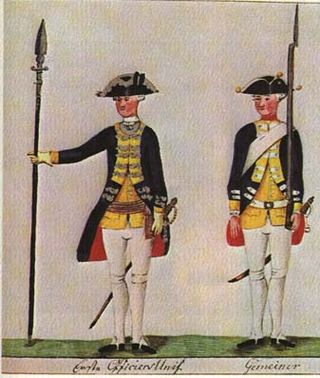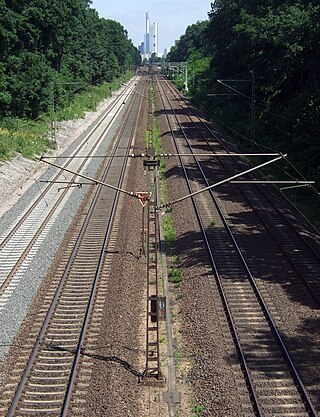Hessian State Library may refer to:
Hessian State Library may refer to:

Hesse or Hessia, officially the State of Hesse, is a state in Germany. Its capital city is Wiesbaden, and the largest urban area is Frankfurt, which is also the country's principal financial centre. Two other major historic cities are Darmstadt and Kassel. With an area of 21,114.73 square kilometers and a population of over six million, it ranks seventh and fifth, respectively, among the sixteen German states. Frankfurt Rhine-Main, Germany's second-largest metropolitan area, is mainly located in Hesse.

Darmstadt is a city in the state of Hesse in Germany, located in the southern part of the Rhine-Main-Area. Darmstadt has around 160,000 inhabitants, making it the fourth largest city in the state of Hesse after Frankfurt am Main, Wiesbaden, and Kassel.

The Landgraviate of Hesse-Kassel, spelled Hesse-Cassel during its entire existence, was a state in the Holy Roman Empire that was directly subject to the Emperor. The state was created in 1567 when the Landgraviate of Hesse was divided upon the death of Philip I, Landgrave of Hesse. His eldest son William IV inherited the northern half of the Landgraviate and the capital of Kassel. The other sons received the Landgraviate of Hesse-Marburg, the Landgraviate of Hesse-Rheinfels and the Landgraviate of Hesse-Darmstadt.

Hessians were German soldiers who served as auxiliaries to the British Army during the American Revolutionary War. The term is an American synecdoche for all Germans who fought on the British side, since 65% came from the German states of Hesse-Kassel and Hesse-Hanau. Known for their discipline and martial prowess, around 30,000 Germans fought for the British during the war, around 25% of British land forces.

University of Giessen, official name Justus Liebig University Giessen, is a large public research university in Giessen, Hesse, Germany. It is named after its most famous faculty member, Justus von Liebig, the founder of modern agricultural chemistry and inventor of artificial fertiliser. It covers the areas of arts/humanities, business, dentistry, economics, law, medicine, science, social sciences, and veterinary medicine. Its university hospital, which has two sites, Giessen and Marburg, is the only private university hospital in Germany.

The Technische Universität Darmstadt, commonly known as TU Darmstadt, is a research university in the city of Darmstadt, Germany. It was founded in 1877 and received the right to award doctorates in 1899. In 1882, it was the first university in the world to set up a chair in electrical engineering. In 1883, the university founded the first faculty of electrical engineering and introduced the world's first degree course in electrical engineering. In 2004, it became the first German university to be declared as an autonomous university. TU Darmstadt has assumed a pioneering role in Germany. Computer science, electrical engineering, artificial intelligence, mechatronics, business informatics, political science and many more courses were introduced as scientific disciplines in Germany by Darmstadt faculty.
Stadtschloss is the German word for a palace of a town, and may refer to:

The People's State of Hesse was one of the constituent states of Germany from 1918 to 1945, as the successor to the Grand Duchy of Hesse after the defeat of the German Empire in World War I, on the territory of the current German states of Hesse and the Rhineland-Palatinate. The State was established after Grand Duke Ernest Louis was deposed on 9 November 1918. The term "People's State" referred to the fact that the new state was a Republic and was used in the same manner as the term Free State, which was employed by most of the other German States in this period.

The Grand Duchy of Hesse and by Rhine was a grand duchy in western Germany that existed from 1806 to 1918. The Grand Duchy originally formed from the Landgraviate of Hesse-Darmstadt in 1806 as the Grand Duchy of Hesse. It assumed the name Hesse and bei Rhein in 1816 to distinguish itself from the Electorate of Hesse, which had formed from neighbouring Hesse-Kassel. Colloquially, the grand duchy continued to be known by its former name of Hesse-Darmstadt.

The Landgraviate of Hesse-Darmstadt was a State of the Holy Roman Empire, ruled by a younger branch of the House of Hesse. It was formed in 1567 following the division of the Landgraviate of Hesse between the four sons of Landgrave Philip I.

The Landgraviate of Hesse was a principality of the Holy Roman Empire. It existed as a single entity from 1264 to 1567, when it was divided among the sons of Philip I, Landgrave of Hesse.

Natalia Alexeievna, Tsarevna of Russia was the first wife of Paul Petrovich, Tsarevich of Russia, son of the Empress Catherine II. She was born as Princess Wilhelmina Louisa of Hesse-Darmstadt as the fifth child of Louis IX, Landgrave of Hesse-Darmstadt and his spouse Countess Palatine Caroline of Zweibrücken.

The Grand Duchy of Hesse State Railways belonged to the Länderbahnen at the time of the German Empire. In the 19th century, the Grand Duchy of Hesse consisted of three provinces. Between the rivers Rhine, Main and Neckar the province of Starkenburg embraced the Odenwald and the Hessian Ried. It also included the ducal residence of Darmstadt. West of the Rhine, was the province of Rhenish Hesse (Rheinhessen) with the towns of Mainz, Worms and Bingen. The province of Upper Hesse (Oberhessen), which included the Vogelsberg and the Wetterau was not directly linked by land to the others. As a result of its lack of territorial integrity, the state did not initially build its own state railway. Rather it took part in joint state railway projects with its neighbouring states: These were the:

The Hessian Ludwig Railway or HLB with its network of 697 kilometres of railway was one of the largest privately owned railway companies in Germany.

The Main-Neckar Railway is a main line railway west of the Odenwald in the Upper Rhine Plain of Germany that connects Frankfurt am Main to Heidelberg via Darmstadt, Bensheim and Weinheim. It was opened in 1846 and is one of the oldest railways in Germany.

Countess Charlotte of Hanau-Lichtenberg, full name: Countess Charlotte Christine Magdalene Johanna of Hanau-Lichtenberg was the wife of landgrave Louis VIII of Hesse-Darmstadt.

Dorothea Friederike of Brandenburg-Ansbach was the daughter of Margrave John Frederick of Brandenburg-Ansbach (1654–1686) and his first wife, Margravine Johanna Elisabeth of Baden-Durlach (1651–1680). She was a half-sister of Queen Caroline of Great Britain, the wife of King George II.
The Hessian Bibliography is a German regional bibliography. Its aim is to completely capture all the literature connected with the geography, history and culture of the German federal state of Hesse from the year 1974. It is based on the holdings of the copyright libraries at Kassel, Fulda, Frankfurt, Wiesbaden and Darmstadt.
Hessian State Museum may refer to:
Margaret, Princess of Hesse and by Rhine was the wife of Louis, Prince of Hesse and by Rhine, the last prince of the House of Hesse-Darmstadt. Born in Ireland, she became a noted art patron in her adopted homeland of Germany.